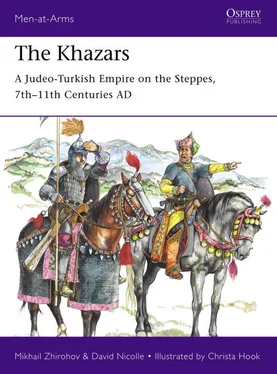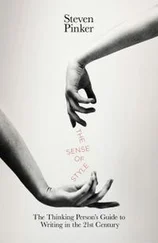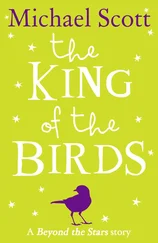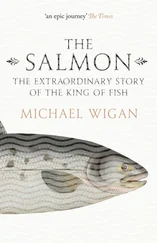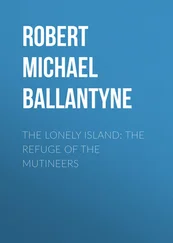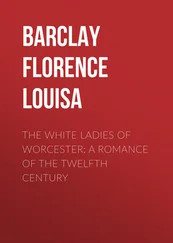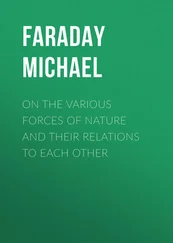G2: Khazar Jewish warrior, 9th century
How far the conversion of the Khazar ruling elite to Judaism filtered down into lower ranks of society remains a matter of scholarly debate; it may perhaps have been confined to the higher aristocracy, and the elites of some Khazar sub-tribes. Whether the Judaism practised by the Khazars was mainstream or otherwise is also a matter of some dispute. The prosperous tribesman shown here, wearing a fine silk coat under his war gear, has been given a kippah skull-cap and payot side-locks, though there is no real evidence for these being adopted by the Judeo-Khazars. Apart from a recently discovered segmented helmet with Jewish symbols on the front and back, which he carries, this man is equipped in typical Khazar style: a mail hauberk, a cuirass of large iron lamellae, iron shoulder plates, and strapped-on iron greaves. His weapons are a fine Khazar sabre with a lightly curved hilt and silvered fittings, and a war-flail with a bronze weight.
G3: Vyatchian Slav tribesman, 8th–9th centuries
The Vyatchi Eastern Slavs, from the Oka river basin south of present-day Moscow, were undoubtedly poor in comparison with their Khazar overlords, despite the metal torque worn around this man’s neck and his finely made leather boots. With neither helmet nor armour, his only protection is a substantial wooden shield, here leaning against the wall with one light and one heavier javelin; he also has an axe in his belt. The embroidered strips at the neck, chest, upper arms and hem of his linen shirt are again believed to have served as a form of tribal identification.
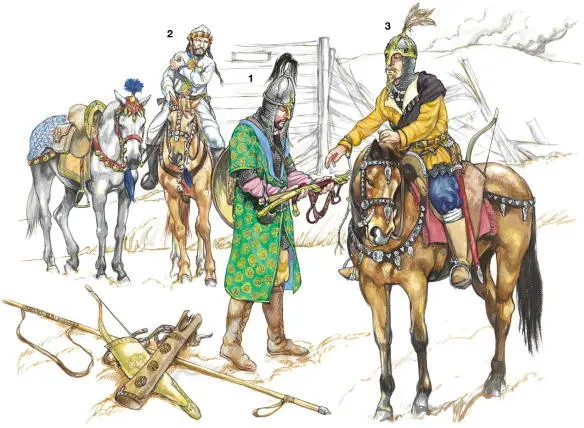
1: Khazar commander surrendering
2: Khazar warrior
3: Rus leader
H1: Khazar commander
The wealth of the Khazar Khaganate, which had attracted the predatory attentions of the Varangian Rus, was reflected in the equipment of its military elites. However, there now appears to have been less use of lamellar armour and a seemingly greater reliance on fine-quality mail, like the short-sleeved hauberk worn by this senior figure handing over his sabre and axe to a victor in token of surrender. His helmet is still of segmented construction, similar to those of the Muslims to the south and the Rus to the north, and has a mail aventail which could probably be tied beneath the chin. His shield is probably of leather-covered wood, but might equally have been entirely of hide, and imported from far beyond Khazar territory. The shirt worn beneath his hauberk is, for example, of pink Chinese silk; his woollen coat is not only covered in patterned Persian silk but is cut in an originally Arab-Persian style as a kaftan, rather than in the considerably overlapping double-breasted Turco-Mongol manner. The embroidered ‘blanket’ which is tailored to go over and around the rump of his horse (background) was probably made locally.
H2: Khazar warrior
Hardly visible, the wounded warrior who accompanies his commander would also illustrate the multi-cultural character of the later Khazar Khaganate. Under his fur-trimmed cap, his long hair tied into pigtails is typically Turkish. His off-white coat, originally of Alan or Persian style, has blue edging at neck and cuffs and a broad band of red, yellow and blue patterned Persian silk all the way down the front, which is fastened with silver clasps. He might have a short double-edged broadsword imported from Russia, but with a German-made blade. His archery equipment and horse harness would still be of typical nomadic steppes types.
H3: Rus leader
By the end of the 9th century the Varangian Vikings who created the large and rapidly expanding state of Kievan Rus had adopted many aspects of the military technology of the Eurasian steppe peoples, mostly notably from the Khazars, and thus had little visibly in common with their Scandianian ancestors. Those Viking features which most obviously endured were straight, double-edged swords, and large-bladed war axes. This commander wears a silver neck torque with pendant Thor’s hammers, and his sword has a trilobate pommel, but the other aspects of his panoply are fully within the Eurasian steppe tradition. His helmet is gilded except for the steel bowl, and worn with a mail aventail. His short mail hauberk is concealed, except at the dagged hem, by a short, linen-lined, overlapping woollen coat; its horn buttons and cord loops are themselves hidden here by a dark cloak folded diagonally around the body and pinned on the right side. Linen puttees are wrapped around the woollen trousers, within soft leather boots. His archery equipment, riding whip and horse harness are all of steppes patterns (like the discarded bow and quiver of H1), though he might have an axe of Scandinavian form hung from the right of his saddle, perhaps with chiselled decoration on the blade suitable for his high status.
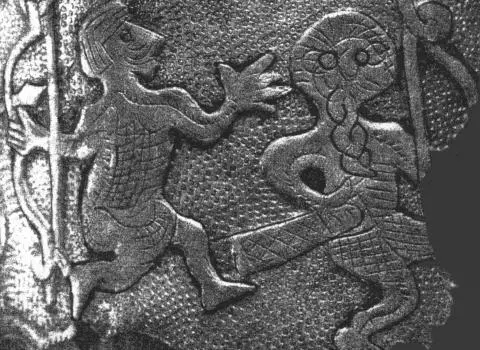
Detail of decorated silver strengthening band of a goat’s-horn from the early Varangian ‘Black Grave’ (Chiornaia Mogila) barrow in Chernihiv, late 10th century. Identifiable details include reflex bows, a quiver (right), and apparently lamellar armour (left), but the right-hand figure appears to have a long plaited beard. By this date the Rus had adopted much of the material culture of the steppes. (Archive of M Zhirohov)
MIKHAIL ZHIROHOV, born 1974, is a military historian; a graduate of Donetsk State University, Ukraine, he lives in Chernihiv. His interests extend from the medieval history of the territories of the former USSR to modern warfare, and he is the author of some 20 books in Russian and Ukrainian, on subjects including the Mius Front in 1941–43, Soviet military aviation over Afghanistan in 1979–89, and modern hybrid warfare. He has also published more than 300 articles on various aspects of military history in Russian, Ukrainian, English, Serbian and French journals.
DAVID NICOLLE is Visiting Research Fellow at the Institute of Medieval Studies, Nottingham University. A specialist in the military history of Islam, he is the author of over a dozen books on medieval military history, and has been a prolific contributor to Osprey series for many years.
ILLUSTRATOR
CHRISTA HOOK began her illustrating career in 1986, after studying under her father Richard Hook. Her work has featured extensively in the worlds of publishing and television. She has established herself as one of Osprey’s most popular artists, having illustrated multiple series titles. Her illustrations are sought after by collectors worldwide. Christa lives and works in East Sussex, England.
Discover more at www.ospreypublishing.com
OSPREY PUBLISHING
Bloomsbury Publishing Plc
PO Box 883, Oxford, OX1 9PL, UK
1385 Broadway, 5th Floor, New York, NY 10018, USA
E-mail: info@ospreypublishing.com
www.ospreypublishing.com
OSPREY is a trademark of Osprey Publishing Ltd
First published in Great Britain in 2019
This electronic edition published in 2018 by Bloomsbury Publishing Plc.
© Osprey Publishing Ltd, 2019
All rights reserved. No part of this publication may be reproduced or transmitted in any form or by any means, electronic or mechanical, including photocopying, recording, or any information storage or retrieval system, without prior permission in writing from the publishers.
Читать дальше
